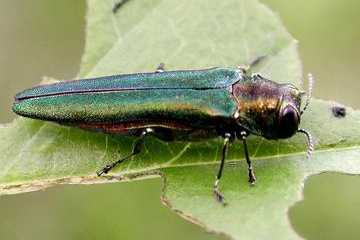Emerald Ash Borer Pest Information


Description
The emerald ash borer is a small but destructive beetle. It has four life stages: adult, egg, larva and pupa. The slightly flattened, white to cream-colored larvae have 10 abdominal segments, with the segments towards the end of the body resembling bells that are nested one upon the other. Emerald ash borer larvae reach an average length of 1 1/2 inches (38 mm). The adult beetle has a shiny emerald green body with a coppery red or purple abdomen (only visible when the wings are spread). Adult beetles leave distinctive D-shaped exit holes in the outer bark of the branches and the trunk. Adults are roughly 3/8 to 5/8 inches long with metallic green wing covers and a coppery red or purple abdomen. The adults may be seen from late May through early September but are most common in June and July (New York State Department of Environmental Conservation).
History and Distribution
Emerald ash borer currently is not established in California.
Emerald ash borer is native to Asia, including China, Japan, North Korea, South Korea, Mongolia, the Russian Far East, and Taiwan (Center for Plant Health Science and Technology). It has been introduced to Canada (Manitoba, Ontario, Quebec, Nova Scotia, and New Brunswick), the United States (widespread in the eastern United States and also in Colorado), European Russia, and Ukraine (Government of Canada; Orlova-Bienkowskaja et al., 2020).
Current Known United States Distribution
Host Range
In North America, the emerald ash borer is known for attacking and killing ash trees, Fraxinus spp. (including F. americana, F. chinensis, F. latifolia, F. mandshurica, F. nigra, F. pennsylvanica, and F. velutina). It can also attack other woody species in the olive family (Oleaceae), such as fringe-tree (Chionanthus spp.) and olive (Olea europaea). The susceptibility of ash trees is species-dependent. Species from the native range of emerald ash borer are reported to be much less susceptible than species native to North America. Experimental evidence suggests stress (including drought) increases trees' susceptibility. Olive trees are attacked under experimental conditions. The host suitability of (and impact on) olive trees is dependent on variety.
Life Cycle (from New York State Department of Environmental Conservation)
In northeastern North America, the emerald ash borer generally has a one-year life cycle (in some cases, the life cycle may last two years), emerging from beneath the bark of ash trees in late May or early June, with peak activity between mid-June and early July. The adult flight season is finished by early August. Adult emerald ash borers are most active during the day and favor sunny, warm weather. The life span of adult emerald ash borers is about three weeks. Adult emerald ash borers feed along the margins of leaves, leaving small, irregularly-shaped edges. Newly emerged adults must feed for at least several days before mating. An average female may lay from 60 to 100 eggs during her lifespan, placing the eggs singly in bark crevices or under bark flaps on the trunk or branches. Eggs hatch in seven to 10 days. After hatching, the first instar larvae chew through the outer bark and feed in the living inner bark (cambium layer) of the host tree. As they feed the larvae wind back and forth, creating serpentine (S-shaped) “galleries” characteristic of this wood-boring beetle. When emerald ash borer finish feeding, the final galleries can extend from four to 20 inches (10 to 50 cm) in length. Adult emerald ash borers typically fly less than ½ mile from their emergence tree. Most long-distance movement of emerald ash borer has been directly traced to ash firewood or ash nursery stock. California currently has a regulation restricting the importation of ash firewood and other potentially infested material to protect our environment from this pest.
Damage to Agriculture and Environment
Adult emerald ash borers feed on leaves (including those of ash (Fraxinus spp.) and white fringetree (Chionanthus virginicus), although this is not reported to cause significant damage (Peterson, 2019). Significant damage is caused by larval feeding. Eggs are laid on tree branches or trunks from 2.5 to more than 90 cm diameter (McCullough, 2019). The larvae tunnel into and feed on phloem and outer sapwood. The feeding damage causes dieback and eventual death (in as little as two years) of the tree (United States Department of Agriculture, 2018).
Emerald ash borer is well-known to kill healthy trees on a large scale. It is estimated to have killed millions of ash trees in the eastern United States and is likely to have had ecosystem-level impacts there. For example, overstory ash trees have nearly disappeared from southeastern Michigan (Hoven et al., 2020; Ward et al., 2021). It is considered by some to be the most significant (in terms of cost and damage) forest pest to have ever invaded North America.
Emerald ash borer is reported to attack two species of ash native to California, Fraxinus latifolia and F. velutina. The other species present may be attacked as well. One of the native California species known to be attacked, Fraxinus latifolia (Oregon ash), suffered decline and 100% mortality within five years in a common garden experiment in Michigan (Herms, 2015). This tree is widespread in California and is found along the entire length of the state from the coast to the Sierra Nevada (CalFlora).
The olive industry in California is worth tens of millions of dollars annually. If emerald ash borer becomes established in California and attacked olive trees here, it could lower crop yield and increase crop production costs.
